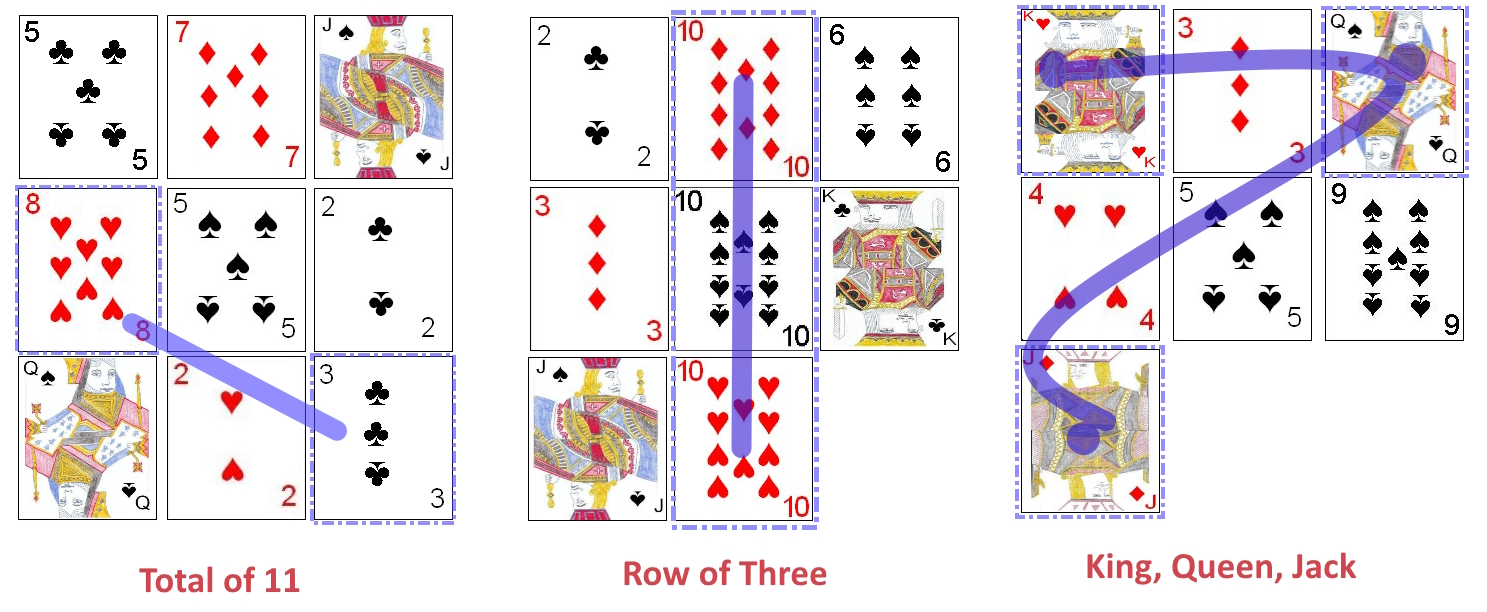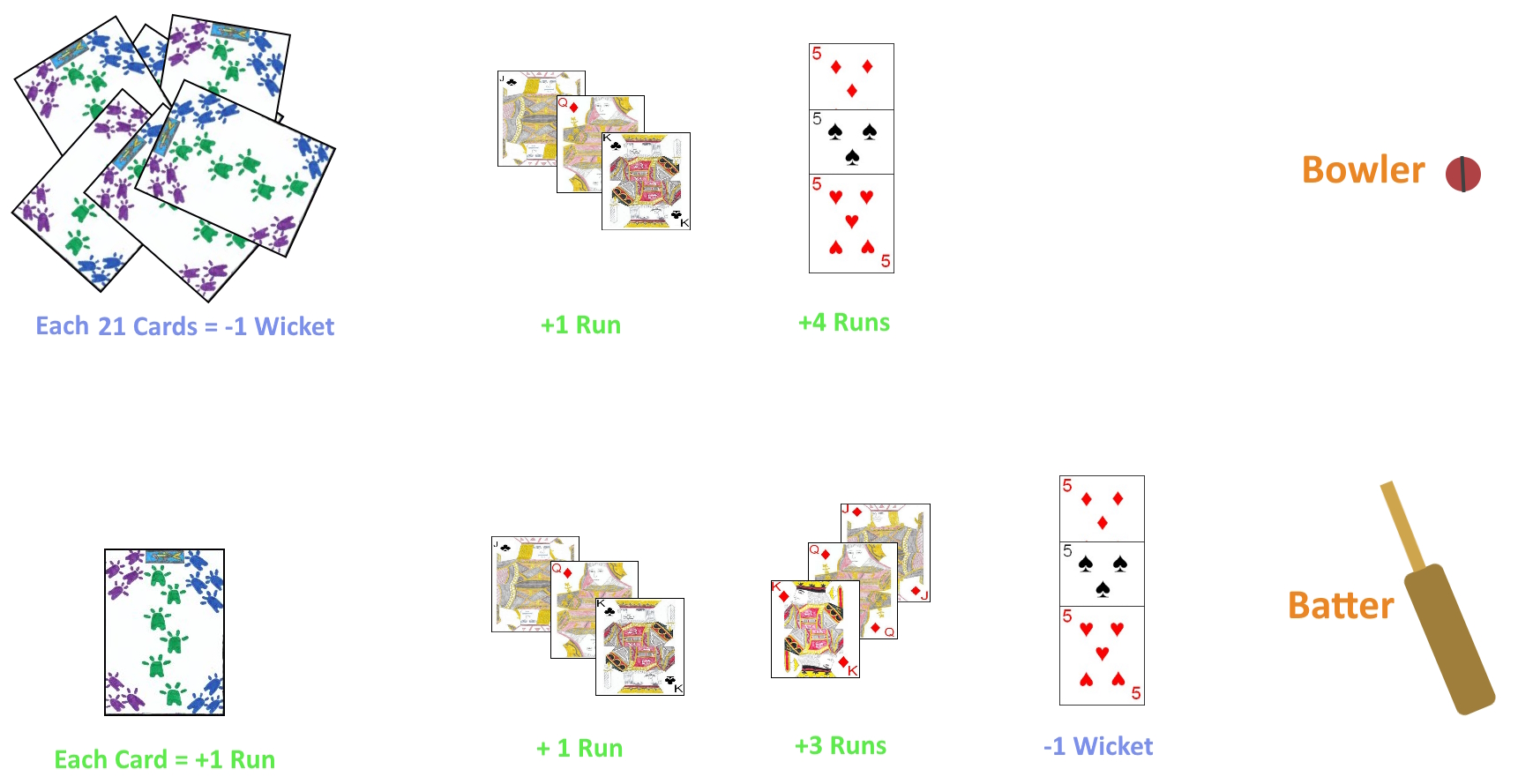Alternate Rule set: An alternate rule set for playing this game was submitted in 2006 by
Derek Hill, in the letters section of the British newspaper, the
Daily Mail.
The alternate version of the same is played very similarly to the standard game with a few differences which make for a faster and simpler game. The following are the differences as described for that version:
- In this version, the batting player starts first instead of the bowling player.
- Showing a Jack, Queen and King on the grid still may be covered by the player whose turn it is, but do not earn any runs for the batting player as in the standard version of the game.
- Three cards in a line on any grid of the exact same rank always cause one wicket to fall for the current batter, regardless of which player is actually playing his turn.
- Three cards in a direct sequence (regardless of suit) in a line on the grid, during either player's turn, force the fall of one wicket, for the current batter. For the purposes of these sequences, the sequencing of the cards in the deck are as follows: Ace, 2, 3, 4, 5, 6, 7, 8, 9, 10, Jack, Queen, King, Ace. Aces can be considered either high or low, and thus can appear at the top or bottom of a sequence which contains them.
In all other aspects this alternate version of the game is played identically to the standard game as described above.
Copyright © 2015 CatsAtCards.com. All rights reserved.
 During each turn, a player thus begins by thoroughly shuffling the deck and placing it face-down on the table. He then begins dealing a layout of nine cards, in three rows of three cards each. He deals in sequence starting with the upper left card in the layout and finishing with the bottom right card in the layout. However, as the player deals, if certain combinations appear as he deals the grid, he then immediately covers each of the cards that are part of that combination with new cards from the deck. As soon as such a combination is discovered, the player should immediately cover the cards in that combination with new cards
from the deck. If, in covering these cards with new combinations he creates a new combination in the layout, once he completes covering the cards from the previous combination, he can then cover the cards in the new combination. After covering these cards, he can then continue dealing out the remaining cards to complete the 3 by 3 card grid.
During each turn, a player thus begins by thoroughly shuffling the deck and placing it face-down on the table. He then begins dealing a layout of nine cards, in three rows of three cards each. He deals in sequence starting with the upper left card in the layout and finishing with the bottom right card in the layout. However, as the player deals, if certain combinations appear as he deals the grid, he then immediately covers each of the cards that are part of that combination with new cards from the deck. As soon as such a combination is discovered, the player should immediately cover the cards in that combination with new cards
from the deck. If, in covering these cards with new combinations he creates a new combination in the layout, once he completes covering the cards from the previous combination, he can then cover the cards in the new combination. After covering these cards, he can then continue dealing out the remaining cards to complete the 3 by 3 card grid.
 For the bowling player, if he manages to play a total of 21 cards,
this equates to the fall of one wicket. For each additional 21 cards he managed
to play during that turn, one additional wicket falls. Thus, the bowling player,
over the course of one or more of these turns, should keep a running total of
the number of wickets that fall. Each player has a total of 10 wickets before
their turn as batter ends. Thus, once these 10 wickets have fallen, the inning will immediately end
for the current batter. For each combination of Jack, Queen, King found in the layout
during the bowling player's turn, the batting player earns one
additional run. For each combination of three cards of the exact same rank in a line, the batting player earns 4
additional runs.
For the bowling player, if he manages to play a total of 21 cards,
this equates to the fall of one wicket. For each additional 21 cards he managed
to play during that turn, one additional wicket falls. Thus, the bowling player,
over the course of one or more of these turns, should keep a running total of
the number of wickets that fall. Each player has a total of 10 wickets before
their turn as batter ends. Thus, once these 10 wickets have fallen, the inning will immediately end
for the current batter. For each combination of Jack, Queen, King found in the layout
during the bowling player's turn, the batting player earns one
additional run. For each combination of three cards of the exact same rank in a line, the batting player earns 4
additional runs.